#Brontothere
Text
Today's #Spectember concept is a combination of a couple of anonymous submissions:
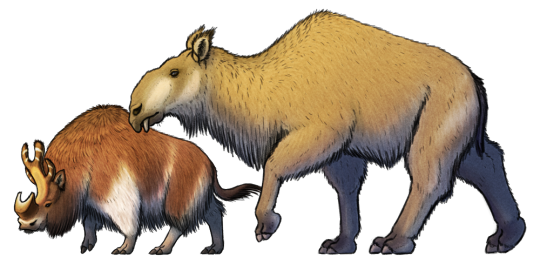
These two animals are the descendants of brontotheres and paraceratheres, almost the last living representatives of their kinds, hanging on in the equivalent of modern-day times in a world similar to our own.
But in this timeline some of the North American brontotheres managed to cope with the cooling drying climate of the Oligocene, adapting their teeth and their diet to grazing the spreading scrublands and grasslands. They became smaller and somewhat less bulky, built more like tapirs or wild boars than their previous rhino-like forms, and although they were now able to move faster in the more open environments their main defense was actually their highly social herding behavior – relying on strength in numbers and collectively mobbing predators.
Males also developed increasingly elaborate head ornamentation, like mammalian versions of ceratopsids, with ossicone-like projections on the back of their skulls as well as on their noses.
But they never regained their kind's previous success or diversity, instead remaining as a fairly minor element of the North American plains fauna. They began to decline against the rise of more specialized ungulates and smarter pack-hunting carnivorans, but one lineage did manage to disperse into South America during the Great American Biotic Interchange before the remaining North American brontotheres died out entirely.

Now the crowned brontothere (Brontochlos coronatus) is one of the last remnants of the whole group*, living in the Patagonian Steppe of southern South America. A relict species from the last ice age, under its thick coat of hair it's only about the size of a sheep – around 1m tall (3'3").
(*There is one other still-extant lineage of brontotheres in this world, but that's a subject for another time.)
———
Meanwhile the Asian paraceratheres survived and went through a similar shift towards tougher diets and smaller body size. No longer the titans they once were, they never again exceeded the size of the largest horses and instead converged on camelids and macraucheniids.
They reached North America via Beringia in the late Miocene, but struggled to establish themselves alongside the native camelids at the time – and the later camel dispersal into Asia would eventually push the remaining paraceratheres there towards extinction, too. But, much like the brontotheres, a few paraceratheres did make it all the way down into South America and persisted for longer, taking advantage of the ecological vacancies left by the already-dwindling native ungulates.

The woolly paracerathere (Ebursonora glacialis) is one of the last paraceratheres, sharing the same Patagonian Steppe habitat as the crowned brontotheres. Just under 2m tall (6'6"), it has a highly prehensile upper lip and a large bulbous nasal cavity that acts as both a saiga-like air filter and as a resonating chamber.
———
Despite sometimes competing with each other for the same food resources, these two species have developed something of a mutualistic relationship with each other. The social crowned brontotheres will often incorporate one or two woolly paraceratheres into their herds – often young "solitary" males of the species – due to the paraceratheres' larger size and better ability to spot threats at a distance. In exchange for acting as an early warning system, the paraceratheres gain the protection of the whole brontothere mob, increasing their own survival odds in a harsh environment still stalked by sabertoothed cats and the occasional terror bird.
———
Nix Illustration | Tumblr | Twitter | Patreon
#spectember#spectember 2022#speculative evolution#brontothere#paracerathere#perissodactyla#ungulate#mammal#art#science illustration
358 notes
·
View notes
Text
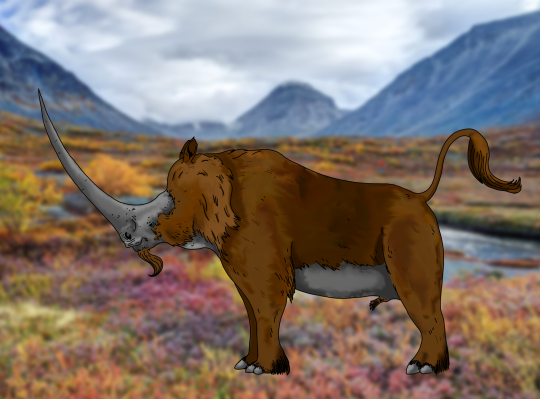
A somewhat brontothere-inspired Unicorn drawn for @adanceofdumbasses. This is the summer coat, a lot shorter than the winter pelt.
43 notes
·
View notes
Text

Carl & Frank
0 notes
Text
But while more than half of the nearly 60 known brontothere species tipped the scale at over a metric ton, the first footfalls of these “thunder beasts” weren’t thunderous at all. When the earliest brontotheres appeared in the lush forests of ancient North America and Asia in the early Eocene Epoch, roughly 56 million years ago, they were about the size of a border collie — hardly the stuff of thundering herds.
Within about 16 million years, these modest mammals had grown into a family of giants.
0 notes
Text
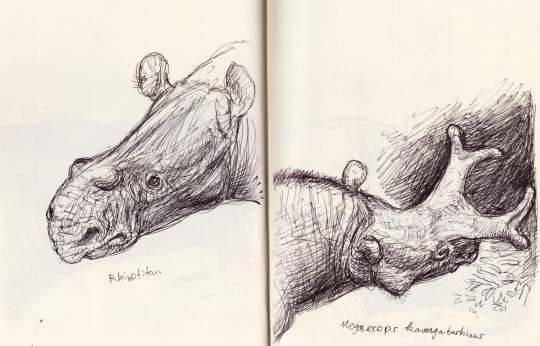


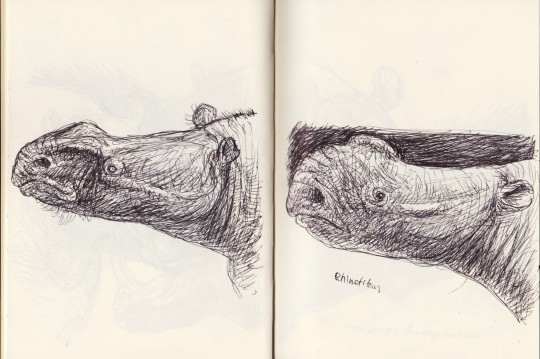

Some pages from one of my sketchbooks.
For some time I looked a little more at brontotheres, an often overlooked but beautiful and diverse group of mammals.
310 notes
·
View notes
Text

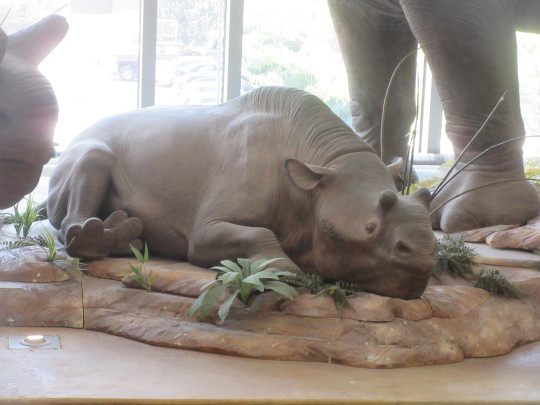

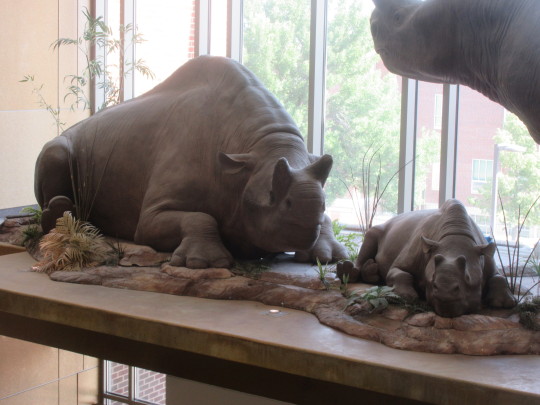
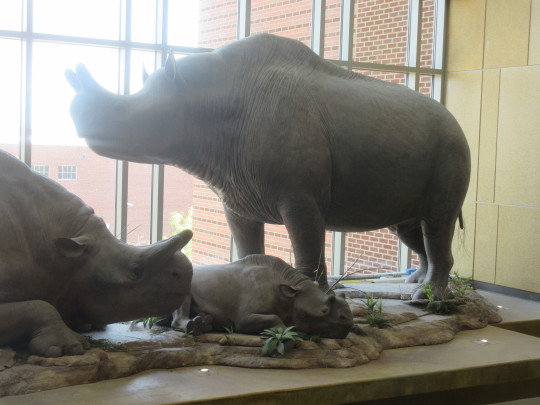

Brontothere Family, South Dakota School of Mines and Technology Paleontology Research Center
Relocated from the Field Museum
23 notes
·
View notes
Text
Monarch Episode 9
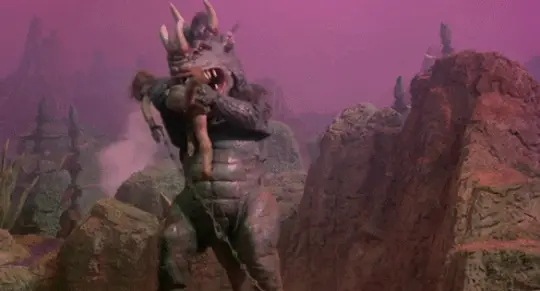
If I had a nickel for every time a piece of monster media featured a warthog-like monster at the center of the earth, I would have two nickels.
If I also had a nickel for every time a piece of monster media that qualified for the prior criteria also had a scientist character trapped at the earths core construct a bow out of local material, I would have four nickels in total.
#kaiju#kaiju tv#monster#monster movie#bramble boar#brontotherium#mastodonosaurus#apologies to anyone looking up actual brontotheres or temnospondyls
1 note
·
View note
Photo
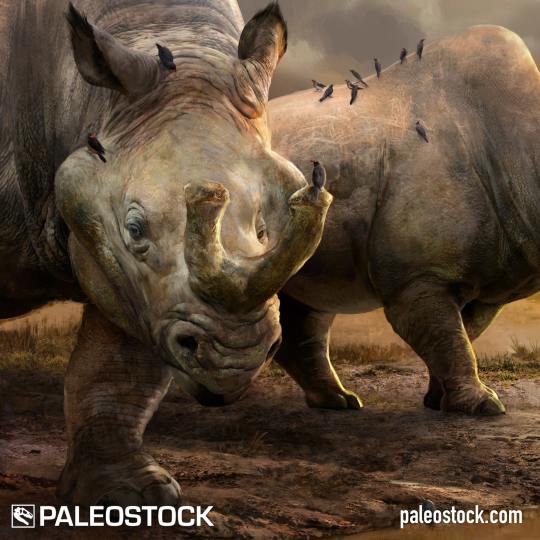
Brontotheres
Brontotheres were massive odd-toed ungulates that lived in the Eocene Epoch.
License this stock resource at: https://paleostock.com/resource/brontotheres-stock-photo
Illustration by Lucas Lima
#paleoart#sciart#science#nature#paleontology#geology#fossil#fossils#evolution#art#illustration#paleostock
103 notes
·
View notes
Text

Day 27: Beast
Megacerops (formerly known as Brontotherium) is the most bizarre ancient beast of the Cenozoic era.
By the way, did you know why megacerops has a speculative mane on the dorsal along with a under chin beards, it’s mainly because other brontotheres are closely related to horses than to rhinos and tapirs?
5 notes
·
View notes
Text
Squeezing in one last bonus #Spectember post this year!
This one isn't based on a specific prompt, but instead is a companion piece to a previous one.
———
While North American brontotheres were adapting to the spread of grasslands, some of their Asian cousins took a very different evolutionary path through the rest of the Cenozoic.
Some Asian brontotheres became aquatic hippo-like animals, with thick dense bones and flipper-like feet, moving into shallow coastal marine habitats and grazing on seagrasses. They developed a convergently similar lifestyle to desmostylians, fairly slow swimmers that "bottom-walked" along the seafloor to feed – but they weren't in direct competition due to occupying more southerly waters in the west Pacific than the desmostylians, ranging from Southeast Asia down to Oceania.
Like other brontotheres they developed some strange nasal bones (similar to those of Embolotherium) forming a raised snorkel-like nose that allowed them to breathe without fully surfacing.
Many of these aquatic turret-nosed brontotheres eventually declined and went extinct during the Miocene and Pliocene, when cooling climates and dropping sea levels removed many of the shallow seagrass meadows they relied on, and dugongs began competing with them for the same limited food resources.
But one lineage hung on down in Australia.

The false bunyip (Scanduladorsum pumilum) is a diminutive aquatic brontothere, about the size of a pygmy hippo at 75cm tall (2'6"). It has reverted to a slightly more amphibious lifestyle compared to its almost fully-aquatic extinct relatives, and unusually for its kind it's also primarily a freshwater species, living in lakes, rivers, and marshes – but migrating down to congregate in estuaries and shallow marine waters during the breeding season.
It spends daytime submerged underwater with just its "snorkel" nose poking above the surface, grazing on aquatic plants, then emerges onto land during the evening to supplement its diet with soft terrestrial leaves and fruits, moving with a slow sealion-like gait. Generally solitary, but not territorial, it communicates over long distances with other individuals of its kind using surprisingly loud booming calls, amplified by its large nasal cavity.
It also carries a commensal barnacle (Chelonibia brontes), descended from turtle barnacles. This species has evolved a unique tolerance for freshwater, allowing it to stay attached and alive on its host between trips back to more marine conditions.
———
Nix Illustration | Tumblr | Twitter | Patreon
#spectember#spectember 2022#speculative evolution#brontothere#perissodactyla#ungulate#mammal#barnacle#art#science illustration
181 notes
·
View notes
Text


I've wanted to do an electric Brontothere for ages and since I've got an electric, rhino-adjacent fossil fakemon already in this region, I decided it could make for a good Ancient Power evo instead. As such, Thundercolt was designed as though it could've been a final evo before gaining it's own evolution in a later game (something i've done a few times in this region).
Ponai form small herds, lead by an adult Thundercolt. They don't have the aggressive tendencies of their adult counterparts and so can live together in relative peace, but benefit from their presence to ward off predators. Fast in their own right, their first response is to flee danger but if pressed will fire botls of lightning from their horn.
Thundercolt possess a wild temperament and will squabble when in groups much bigger than three. They adopt herds of Ponai and look after them in return for a more peaceful social solution. As well as firing bolts of lightning with their horns they can sunder the earth with the clatter of their hooves, rumbling both the sky and the land.
Brontremor are heaving beasts of muscle and are indomitable in their will. With such a stalwart defence they have little need to be so grumpy but nevertheless are dangerous pokemon to be around, easily angered and quick to charge. Little can stop them once they begin running and their footsteps are like the breaking thunder.
I was struggling with the poses on these guys so had to do a ref sheet to help me out. Handy to better see their markings too so here it is.
--Attack Info--
--Ability Info--
#tresto#fakemon#fakedex#saucylobster#horse#pony#colt#unicorn#brontotherium#megacerops#brontops#rhinoceros
3 notes
·
View notes
Text


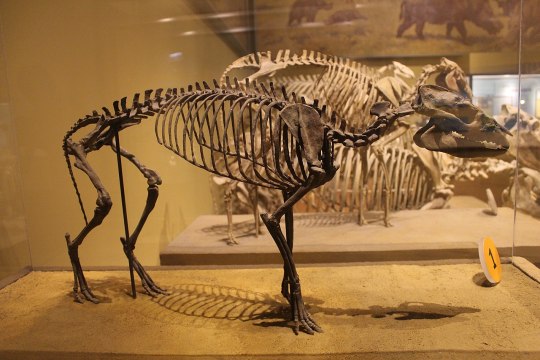
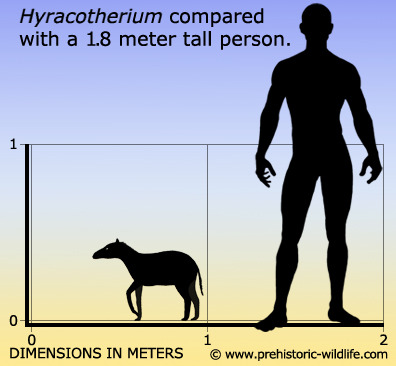
Hyracotherium leporinum
(temporal range: 55-45 mio. years ago)
[text from the Wikipedia article, see also link above]
Hyracotherium (/ˌhaɪrəkoʊˈθɪəriəm, -kə-/ HY-rək-o-THEER-ee-əm; "hyrax-like beast") is an extinct genus of very small (about 60 cm in length) perissodactyl ungulates that was found in the London Clay formation. This small, fox-sized animal is (for some scientists) considered to be the earliest known member of Equidae before the type species, H. leporinum, was reclassified as a palaeothere, a perissodactyl family basal to both horses and brontotheres. The remaining species are now thought to belong to different genera, such as Eohippus, which had previously been synonymised with Hyracotherium.
5 notes
·
View notes
Text
Prompt #18
There is always a chosen one.
Fate does not rest without a champion, and the sacrifice of one prophesised hero is swiftly followed by the nomination of the next. Not only at times of war, upheaval, or looming apocalypse, but also in the eras in between. There are chosen ones fated to do little more than while away the peace. To savour it, perhaps. Or to keep it.
We remember them from the legends, but they can sometimes feel like a rare occurrence: a sudden windfall from the universe to help resolve a crisis, but not needed once it goes away. That isn't true. They have always been there, foreground or backdrop, needed or not. Chosen thousands, passing a baton forwards throughout history. Only one at a time, but never less.
Still, there is a reason that we rarely notice them. The world doesn't revolve around our kind, and other species required heroes long before our first ancestor was born. Once upon a time, an ancient myriapod was destined to take the first few thousand steps onto the shore, a ground sloth triumphed in a long and epic conflict, and a brontothere led her herd into their promised land. There is always a chosen one, a vessel for fate's ineffable designs. They are just rarely human.
This cycle, the universe has chosen the houseplant you just received as a gift. No pressure keeping it alive.
3 notes
·
View notes
Note
HEHEHE HIII, what are YOUR favourite dinosaurs/prehistoric species!!
OOOOOOOHHH BAPY ITS TIME. Thanks for asking!!!! I could literally talk about dinosaurs and palaeontology for days without stopping if you’d let me. You have opened Pandora’s box and it ain’t shutting.
Sosososo I’ve always been a fan of the sauropods, and Brachiosaurus was my first favourite dinosaur, but it was pretty quickly overtaken by Sauroposeidon!! This behemoth from middle Cretaceous USA has often been restored as a pumped-up Brachiosaurus due to its incomplete nature, leading to height estimates of up to 18m tall!!!! MAKING IT THE TALLEST ANIMAL TO EVER EXIST!!!!!! That’s pretty sick in my opinion, though more recent estimates have shaved it down to a still impressive 15m after considering its place on the sauropod evolutionary tree, closer to the titanosaurs than Brachiosaurus is. Sorry I couldn’t help but say my piece about Sauroposeidon while I had the opportunity. It’s still my favourite dinosaur, though the mysterious Bruhathkayosaurus did hold the title for a little while when I was like 8? 9? And I sometimes consider Dreadnoughtus to be joint favourite thanks to a combination of Prehistoric Planet and some talks that I listened to by its discoverer, Kenneth Lacovara.
OTHER FAVOURITE (non avilaean) DINOSAURS INCLUDE, in no particular order:
SAUROPODOMORPHS
Dreadnoughtus, as I mentioned
Unaysaurus
Argentinosaurus
Apatosaurus, PALAEOACCURATE ONLY
Mamenchisaurus
Liaoningtitan
Brachiosaurus
Dzharatitanis
THEROPODS
Dakotaraptor, thanks to Saurian
Latenivenatrix
Zhenyuanlong, thanks to Steve Brusatte
Therizinosaurus
Anzu, again, Saurian
Khaan
Yutyrannus, particularly when restored with the headcrest
Juratyrant
Gorgosaurus
Metriacanthosaurus
Saurophaganax, mainly because it has a kickass name
Carcharodontosaurus
Neovenator, obviously
Eustreptospondylus
Baryonyx
Oxalaia, which is really fun to say
Masiakasaurus
Dracovenator, like Dilophosaurus but more obscure. And from South Africa.
Coelophysis
ORNITHISCHIANS
Triceratops
Turanoceratops
Protoceratops, thanks to Dinosaur Planet
Stegoceras
Aralosaurus
Edmontosaurus, particularly E.annetens
Saurolophus
Charonosaurus, like Parasaurolophus but more obscure. And from China.
Maiasaura, because in BestInSlot hated it in Jurassic World Evolution so it reflexively became one of my favourites out of spite/pity. It’s also cool in its own right don’t get me wrong.
Orodromeus. Hee hee. She dig
Lurdusaurus. I actually think it was Beasts of Bermuda that sold me on this one
Altirhinus. The schnoz on this man
Iguanodon
Rhabdodon
Dryosaurus
Heterodontosaurus
Scelidosaurus, particularly after seeing Prehistoric Kingdom’s rendering of it
Jakapil, newly discovered and straight on the list babey
Stegosaurus
Tuojiangosaurus. Spikey
Sauropelta
Borealopelta. WE KNOW WHAT COLOUR IT WAS!!!!
Ankylosaurus
Saiachania. Yes it is because of Dinosaur King.
Crichtonsaurus
Ok I lied there was an order. I sorted them by taxonomic Order. Also sorry there was so many I kept thinking of more. That was 52 I total??? 53 if you include Sauroposeidon. I just couldn’t decide.
BUT WAIT THERE’S MORE!!!!!
Particularly as of recent, I’ve become really interested in non-dinosaurs, particularly the megafauna of Cenozoic South America. Though I do have a side blog dedicated to lomg whale Basilosaurus, it’s tying with the terror bird Devincenzia for the top spot I think.
OTHER FAVOURITES INCLUDE:
BIRDS
Kelenken, another terror bird
Gastornis, thought to be terror bird-esque up until recently when it was revealed to be a fruit eater
Dinornis, the Moa
Hieriaaetus, Haast’s Eagle
Confusciousornis
Anchiornis, if you consider it a bird
Vegavis
MAMMALS
Megatherium, the largest of the giant ground sloths
Doedicurus
Panochtus
Macrauchenia
Toxodon, which probably lived like a hippo
Thylacosmilus
Hyaenodon, in all its many species
Enteldon, my favourite of the Entelodonts
Embolotherium, the best looking brontothere imo
Chalicotherium
Ancylotherium. I would say thanks to walking with beasts but I think that applies to too many animals here.
Deinotherium
Platybelodon, which I stumbled across in an old encyclopaedia with a friend and had a good laugh at
Coelodonta
Paraceratherium
Leptictidium. The schnoz on this man.
NON-DINOSAURIAN ARCHOSAURS
Hatzegopteryx. WHADDA GAL AMIRITE?
Barbaridactus, thanks to Prehistoric Planet
Tupandactylus
Tropeognathus, thanks to Walking With Dinosaurs, even if they do call it Ornithocheirus.
Thalassodromeus
Istiodactylus
Germanodactylus
Archosaurus. The schnoz on this man
Silesaurus, which is NOT a dinosaur
Desmatosuchus
Saurosuchus, a big land croc
Redondasaurus, one of the largest Phytosaura
Erythrosuchus, with its huge stupid head
Areripesuchus
Dakosaurus, a sea croc
Plesiosuchus, one of the largest sea crocs
Purussaurus
Barinasuchus
Quinkana, the last of the land crocs
NON-ARCHOSAURIAN SAUROPSIDS
Varanus priscus, aka Megalania
Mosasaurus
Tylosaurus
Thalassotitan, also because it has a kickass name
Platecarpus
Pliosaurus, particularly P. rossicus
Kimmerosaurus
Rhomaleosaurus
Tuarangisaurus
Nothosaurus
Temnodontosaurus
Opthalmosaurus
Tanystropheus. NECK
Longisquama
Coelurosauravus. It’s a liddle flying lizard!
Scutosaurus. Chonky dude
NON-MAMMALIAN SYNAPSIDS
Inostrancevia, thanks to Primeval
Lycaenops
Diictodon
Placerias
Lystrosaurus, the survivor
Estemmenosuchus
Tapinocephalus, a barrel of a beast
Edaphosaurus
Dimetrodon
Ophiacodon
NON-AMNIOTE CHORDATES
Koolasuchus, the last of the giant amphibians
Metoposaurus
Prionosuchus
Anthracosaurus
Hynerpeton, thanks to Walking With Monsters
Macnamaraspis
Xiphactinus
Thrissops
Cladoselache, a shark relative
OTHER
Arthropleura
Pulmonoscorpius
Pterygotus
Lyrarapax
Opabinia. IT HAS 5 EYES!!!!
Perisphinctes, a Jurassic ammonite
Belemnotheutis, a Jurassic belemnite
Paradoxoides, a Cambrian trilobite
Ok that’s finally everything. APART FROM THE PLANTS no I’m joking. You see what I said about days? Yeah.
Thank you again for the ask! I hope this wasn’t to much :3
7 notes
·
View notes
Text

Extinct Monsters. Written by H. N. Hutchinson. Illustration by Joseph Smit. 1897.
87 notes
·
View notes
Text
Kitten goes into "flight" mode while watching prehistoric animals TV show
New Post has been published on https://petn.ws/DQI0c
Kitten goes into "flight" mode while watching prehistoric animals TV show
A kitten’s reaction to a terrifying prehistoric animal on TV charging directly at her has left viewers in stitches. If only this poor kitten knew Megacerops are nothing to worry about. The rhinoceros-like creature was a member of the Brontothere group, which all died out at the end of the Eocene epoch, according to the […]
See full article at https://petn.ws/DQI0c
#CatsNews
0 notes